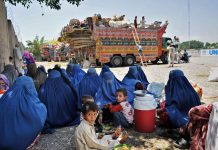Thousands of people gathered at Nishat Chowk, Swat on October 11, 2022, protesting the increasing incidents of violence, and demanding peace. Several other such rallies have been held across Khyber Pakhtunkhwa since last year – in areas as far as Tirah, Dir, Bannu, Buner and so on. So what has been brewing which has made people come out on the streets in otherwise calm areas?
The fall of Kabul to the Taliban in August 2021 yet again cast shadows of uncertainty on the regions bordering Afghanistan. History shows that a change in Afghanistan brings about a profound change in the Pak-Afghan border areas as well. Therefore, there is fear and anxiety among the Pashtun populace here. These fears have been reinforced by the reported presence of the TTP and the surge in terrorist attacks.
The bomb blast in a mosque in Khyber district on July 25 was a reminder of the 2010s. Another deadly attack targeted a JUI political gathering in Bajaur on July 30, claiming the lives of dozens. Sporadic target killings had already kept Bajuar anxious, and peace jirgas were held in the district; but the bomb blast shattered people’s hope for a peaceful future yet again. In Khyber, in response to the bomb blast in the mosque, thousands gathered in Bara town on August 12 for peace. The mass rally was attended by people across political lines.
The calls for attention and action to the authorities are grounded because there is similarity in the events that took place in the region from 2007 to 2016 and the events that are unfolding today. For instance, before the TTP made its presence profound in previous years, it targeted prominent social, political and tribal figures, youth activists and aman (peace) committees’ members. This time again, it has started targeting similar figures in Swat, Bajaur, Peshawar and other Pashtun regions.
The increasing terrorist attacks have naturally invited condemnation and worrying calls from political parties, civil society groups and social media activists in Pashtun regions. People are asking they be taken into confidence in the wake of this ever-changing scenario.
The Awami National Party (ANP), historically the biggest political front against terrorism in the region, and by far the greatest victim of organized violence among the political parties in Pakistan, has been unsurprisingly very vocal about the re-grouping of terrorist outfits since 2019. The party held peace jirgas attended by political parties, professional groups and media persons. In the last of such jirgas, an alliance of political parties and movements named ‘Pakhtun Itihad’ was formed, aimed at highlighting the issues of Pashtuns, the primary issue being peace. Besides that, the ANP’s cadre has been instrumental in organizing peace marches in the Swat-Malakand region and Peshawar Valley, whereas the PTM has been leading the marches in the newly merged districts of KP and the Pashtun areas of Balochistan.
If history somewhat repeated itself in a similar pattern in Afghanistan, will it repeat itself to a similar degree in Pakistan as well, specifically in the presence of anti-war movements and an increasingly politically conscious Pashtun young population equipped with social media?
The exponential rise in terrorist attacks, killings and banned outfits’ public appearance all are factors which tell that the region may witness another era of terror. The response to these developments so far shows that it won’t be like before and that there will be resistance. In the peace marches held since last year, people have categorically rejected and condemned the return of the Taliban. More important is the rallying of people across ideological spectrums. Even so, how long ideologically different fronts can stay united for peace and what shape this public resentment takes in the long-run is open to varying postulations.
Another factor that can potentially influence the days to come is the emergence of social media as an alternate to the mainstream media. Among the younger population, social media is widely used. They have witnessed terror first-hand in the last two decades. Therefore, even though the peace marches have not received media attention, especially on TV, the popularity of the faces of these marches is stunning.
In a nutshell, seeing all that has changed, it is safe to say that a recurrence of the last decade does not seem likely. On the other hand, it is only wise to realize that the forces of terror may have turned darker with the changing realities. In any case, these are not the best of times. And only a politically conscious, informed and responsible populace can ensure the worst of times don’t come again.









































